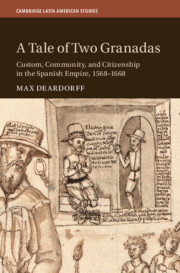Book contents
- A Tale of Two Granadas
- Cambridge Latin American Studies
- A Tale of Two Granadas
- Copyright page
- Contents
- Figures
- Maps
- Tables
- Acknowledgments
- Introduction
- 1 Iberian Antecedents
- 2 Politics, Reform, and the Emergence of Christian Citizenship
- 3 Moriscos, Arabic Old Christians, and Spanish Jurisprudence (1492–1614)
- 4 Cultivating the Christian Republic: The New Kingdom of Granada and the Archbishop Zapata de Cárdenas
- 5 Life in the City: The Casa Poblada and Urban Citizenship
- 6 The Roots of the Mestizo Controversy in the New Kingdom of Granada
- 7 The Mestizo Priesthood
- 8 Mestizo Officials in the Christian Republic
- 9 Urban Indians in Santafé and Tunja, 1568–1668
- Epilogue
- Glossary
- Bibliography
- Index
- Other Books in the Series (continued from page ii)
4 - Cultivating the Christian Republic: The New Kingdom of Granada and the Archbishop Zapata de Cárdenas
Published online by Cambridge University Press: 27 July 2023
- A Tale of Two Granadas
- Cambridge Latin American Studies
- A Tale of Two Granadas
- Copyright page
- Contents
- Figures
- Maps
- Tables
- Acknowledgments
- Introduction
- 1 Iberian Antecedents
- 2 Politics, Reform, and the Emergence of Christian Citizenship
- 3 Moriscos, Arabic Old Christians, and Spanish Jurisprudence (1492–1614)
- 4 Cultivating the Christian Republic: The New Kingdom of Granada and the Archbishop Zapata de Cárdenas
- 5 Life in the City: The Casa Poblada and Urban Citizenship
- 6 The Roots of the Mestizo Controversy in the New Kingdom of Granada
- 7 The Mestizo Priesthood
- 8 Mestizo Officials in the Christian Republic
- 9 Urban Indians in Santafé and Tunja, 1568–1668
- Epilogue
- Glossary
- Bibliography
- Index
- Other Books in the Series (continued from page ii)
Summary
Chapter four turns its attention to the Americas, to observe how the foundational statutes of Christian citizenship made their way into the legislation of colonial synods and councils. To guide the exploration of this corpus, the chapter follows the Archbishop Luis Zapata de Cárdenas of Santafé (1573-1590). A Franciscan with experience in Spain’s ethnically diverse interior frontier, once arrived in Santafé, Zapata developed an innovative program for the Christian evangelization of the native communities. Conducting a deep dive into the conceptual underpinnings of policies in Santafé and across the Indies, chapter four includes a horizontal analysis of synodal and conciliar reform in the subsequent decades. This chapter highlights how core values of the Spanish church – such as Christian education, the inculcation of policía, and the preservation of “good customs” – were under a continual legislative revision that involved actors on both sides of the Atlantic, an ongoing imperial legal revolution whose local changes were the product an era of global transformation.
- Type
- Chapter
- Information
- A Tale of Two GranadasCustom, Community, and Citizenship in the Spanish Empire, 1568–1668, pp. 116 - 141Publisher: Cambridge University PressPrint publication year: 2023

